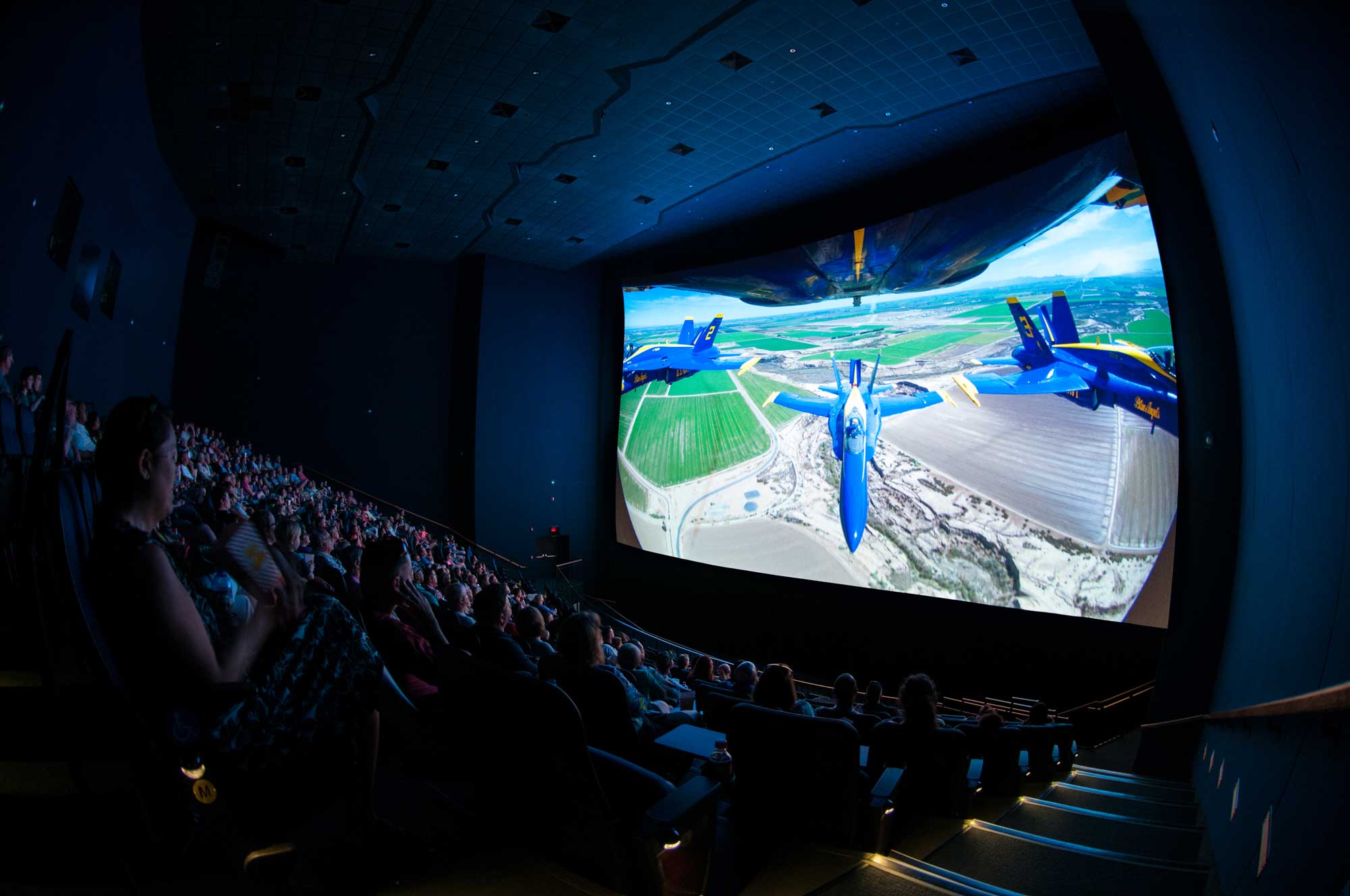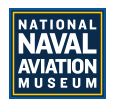Our Mission
The Naval Aviation Museum Foundation provides benefactors the flight path to support the operation, expansion and development of the National Naval Aviation Museum. The Foundation provides resources to support Museum operations, expansion and activity. The Foundation works diligently to raise funds through a variety of gift programs, donations and memberships. All Foundation funding, aside from staffing and operational costs, contributes to program development and growth within the youth STEM programs as well as Museum expansion, aircraft preservation, conservation and maintenance, development of new exhibits and support of day-to-day functions.
STEM Education
The Naval Aviation Museum Foundation operates a number of educational programs designed to inspire children and adolescents to pursue excellence in Science, Technology, Engineering and Mathematics (STEM). Our Flight to Excellence (FTE) field trip program uses the Museum as an educational tool for teachers and visiting students in grades K-12. The Flight Adventure Deck program introduces 6th, 7th and 8th graders to the science of flight, using interactive devices and educational displays. The National Flight Academy, our premier aviation-inspired learning adventure, is a state-of-the-art program that reaches far beyond the traditional academic experience. Aboard AMBITION, our landlocked, virtual aircraft carrier, Aviation eXperimental Pilots (7th-12th graders) live within a completely immersive experience and utilize advanced technology and simulators to plan and fly exciting missions while learning principles of STEM.

National Flight Academy
Since its inception in 2012, more than 17,000 students from 50 states, 29 countries and four US territories have experienced the unparalleled learning adventure aboard AMBITION, a state-of-the-art program housed onboard a 100,000+ square foot virtual aircraft carrier. Attendees – known as AMBITION eXperimental Pilots or AXPs – plan humanitarian missions with ultramodern, advanced technology, learn to fly in 42 networked flight simulators, eat on a mess deck, sleep in staterooms and receive mission briefings in six fully electronic ready rooms. Students are challenged on a wide range of topics from basic three dimensional physics and motion to more advanced concepts of aeronautical engineering and propulsions systems. They encounter challenges that incorporate cybersecurity, underwater remote operated vehicles and more. These missions play into enhancing the students’ education, enriching their understanding of STEM principles. In addition, by working in a team-training environment, leadership development, effective communication and critical thinking skills are emphasized and embedded into each mission. Our flagship program is our 6-day Summer Deployments, in which we host 216 students per week for 12 weeks from May – August. We have found that by placing students in a real world scenario via immersion, simulation and virtual reality, they become far more skilled at scientific theorems, deciphering mathematical equations and finding self-confidence in their own ability to problem-solve. Participants show a measurable increase in knowledge of STEM principles after completing our program. Being located on NAS Pensacola provides us with the unique opportunity to extend their learning into the real world. Students take “port calls” to the National Naval Aviation Museum. They also have the opportunity to watch the Blue Angels practice from the Museum’s flight line.
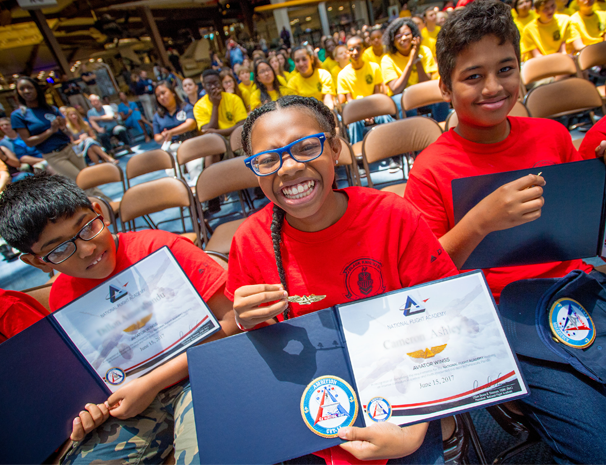
STARBASE Pensacola
Flight Adventure Deck
The Flight Adventure Deck (FAD) encompasses a 9,000-square-foot wing of the Museum. The wing is devoted to the teaching of science, mathematics and technology. Thirty-eight interactive devices, 11 educational kiosks, an interactive wind tunnel and four computer-based flight simulators are incorporated as part of a truly revolutionary educational experience for 6th through 8th grade students.
Tours of the FAD are offered seven days a week at 2 p.m., 3 p.m. and 4 p.m. Specially-trained volunteers will introduce Museum guests to the hands-on science, mathematics and technology program that comprises the FAD. The FAD area is closed when classes are in session. Please check with the Information Desk to be sure a volunteer is available for the tour.
Learning Objective: To understand the principle of buoyancy.
Method: This device consists of a balloon that when filled with hot air rises on a fixed cable, beginning in a deflated state, then filling and rising to a height of 20 feet. The operator can demonstrate with different hot air volumes to achieve positive, neutral or negative buoyancy. Hot air weighs less than the same volume of cold air (it is less dense), which means that hot air will rise up or float when there is cold air around it, just like a bubble of air in a pot of water. This lesson is tied in with the Montgolfier brothers very first unmanned flight in an LTA craft.
Learning Objective: To understand the principle behind Galileo’s Law of Falling Bodies (Gravity).
Method: The device consists of a pair of vertical acrylic tubes with a plunger-operated release mechanism at the top which serves to release a pair of tennis balls simultaneously into the tubes. One ball has been filled with BBs, making it noticeably heavier than the other. When placed into their recesses at the top of the tubes and released, both balls reach the bottom of the tubes simultaneously.
Learning Objective: The device demonstrates the principle that, in the absence of air resistance, all objects at a given location fall with the same constant acceleration.
Method: When the tube is evacuated, the coin and feather fall at the same rate. When air is introduced into the tube, the feather falls at a slower rate.
Learning Objective: To understand the principle behind Galileo’s Law of Falling Bodies (Gravity).
Method: The device consists of a pair of pendulums: one having a bob of cork; the other a bob of lead. When pulled back and released simultaneously, the operator will observe that the initial period (or swing) of both bobs is equal, despite their obvious difference in mass.
Learning Objective: To understand the relationship between weight and mass. (Gravity)
Method: The device consists of a scale and console with touchpads for ten locations in the solar system: Mercury, Venus, Earth, Mars, Jupiter, Saturn, Uranus, Neptune, Pluto, and Moon. When standing on the scale, the operator can select any of these locations and observe how his or her weight changes according to the gravitational pull created by the different masses of the celestial bodies.
Learning Objective: To understand the principles contained in Newton’s Laws of Motion: Inertia, Acceleration and Action-Reaction.
Method: The device consists of a 1.5 meter aluminum beam connected to an air source. Air is blown through small holes at regular intervals the length and width of the beam, creating an air cushion along its surface. Two aluminum “cars” float freely on the air cushion when activated, allowing the operator to accelerate them in a variety of ways in a virtually frictionless environment. One car is equipped with a balloon-nozzle attachment which allows it to be self-propelled. Removable masses can be fitted to the cars to alter their masses for class group experiments.
Learning Objective: To understand the relationship between air pressure and altitude in Earth’s atmosphere.
Method: The device consists of a large acrylic cylinder mounted on a cabinet with a rubber diaphragm in its base. A hand-operated wheel connected to a cam pushes up or pulls down on the diaphragm, increasing or decreasing pressure within the cylinder. A calibrated manometer tube provides a visual display of the atmospheric pressures at key geographic elevations on Earth.
Learning Objective: To understand the relationship between air pressure and altitude in Earth’s atmosphere.
Method: The device consists of a series of weighted bars, each representing the weight of a 1″ square column of atmosphere at a given altitude. Operators can compare the atmospheric weights or pressures between sea level and intervals up to 50,000 feet above sea level (MSL).
Learning Objective: To understand that air is matter which has mass and occupies space.
Method: The device mimics an experiment conducted by Otto von Guericke in Magdeburg, Germany in the 17th century. Two machined aluminum hemispheres are mounted to the top of a cabinet, one fixed and the other mounted on a vertical sliding track which allows it to be moved up and down to form a sphere. With the valve on the upper hemisphere closed and the two hemispheres placed together, a button-actuated vacuum pump removes the air from within the sphere and prevents separation of the two hemispheres.
Learning Objective: To understand Archimedes principle of buoyancy and gas volume vs. pressure (Boyles Law).
Method: The device consists of a water-filled cylinder topped by a lever-operated diaphragm. Two glass Cartesian “divers” or air-filled buoys are suspended in the cylinder. Operation of the lever either increases or decreases pressure on the water column, directly compressing or expanding the volume of air within each diver and causing the diver to ascend or descend.
Learning Objective: To understand the principle of buoyancy.
Method: The device consists of a tethered, helium-filled weather balloon beneath which is suspended a small basket. The operator can experiment with different payloads to achieve positive, neutral or negative buoyancy.
Learning Objective: To understand the variations in density and weight of the volume of given gases that are components of air.
Method: The device consists of a series of weighted bars each representing the weight of 100 cubic feet of a given gas: Oxygen, Carbon Dioxide, Nitrogen, Argon, Hydrogen and Helium.
Learning Objective: To observe an application of Bernoulli’s Principle.
Method: The device consists of a cabinet-enclosed blower and a swiveling air exhaust plenum and ball. When actuated, exhaust air holds the ball in suspension 2-3 feet above the plenum. The operator can rotate plenum to 45° from the vertical and observe that ball remains suspended within the air column.
Learning Objective: This device gives a demonstration of conservation of momentum and energy using a series of swinging spheres.
Learning Objective: To illustrate how the movement of aircraft control surfaces (elevator, aileron and rudder) affects the control and stability of an aircraft in the axes of pitch, roll and yaw.
Method: The device consists of a large wind tunnel containing a 1/16 scale T-34C “Turbomentor” remote-controlled model. The operator sits at a control console equipped with stick, throttle and rudder pedals and flies model in the wind tunnel. Limited control authority and area restrict movement to approximately 3 feet up and down and 3 feet left and right.
Learning Objectives:
- To understand how control movements affect aircraft performance: airspeed, altitude, heading, rate of descent and rate of climb.
- To understand the basic variables essential to piloting an aircraft: attitude, airspeed and power.
- To appreciate the level of situational awareness and eye-to-hand coordination required to pilot an aircraft.
Method: The flight simulator is a highly interactive, highly realistic depiction of the flight environment. The hardware is configured to resemble a hybrid F-18/F-16 jet aircraft cockpit with a full set of controls and basic instruments. Out-the-window view from the cockpit is a wide-angle projection 10 feet wide by 8 feet high. The flight simulator may be configured to provide a concise, “canned” flight program which takes operator through a specific, limited profile (e.g. final approach to a selected runway), or it can be configured to provide an open flight program of unlimited duration and mission profiles.
Learning Objective: To illustrate the mechanical operation of the piston, crankshaft and supercharger of the Cyclone engine.
Method: An operating cutaway of the Cyclone engine shows the mechanical movements of one of the nine pistons and its connecting rod to the engine crankshaft and reduction gearing to the propeller driveshaft. The centrifugal impeller for the supercharger is also displayed.
Learning Objective: To illustrate the mechanical operation of the compression and power turbine sections of a turbojet engine.
Method: An operating cutaway of the J-34 engine shows the mechanical rotation of the driveshaft and the compression and power turbine sections it connects.
Learning Objective: To understand how a gas turbine engine operates: the four stages of power production and how the engine converts fuel and air into thrust.
Method: The fiberoptics in the display above the J-34 cutaway are keyed to buttons on a visitor-operated console which correspond to different sections of the engine and steps in the power-production cycle.
Learning Objective: To observe how a propeller is designed like a “wing with a twist.”
Method: The device consists of a series of cross-sections of a Hartzell propeller blade from a T-34 aircraft. Visitors can observe the sections and compare their shapes with others taken from the same blade.
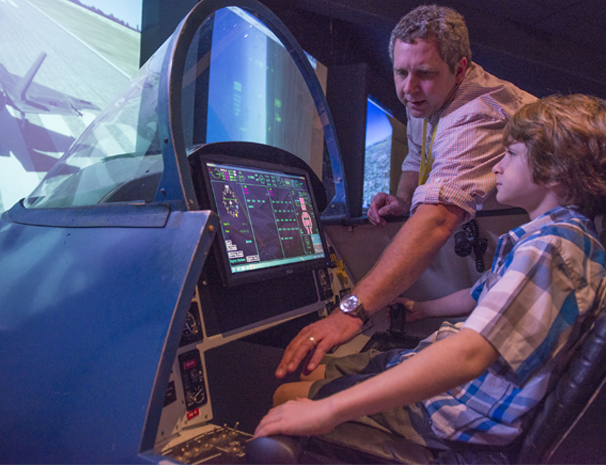
FAD Summer Camp
Sessions run Monday through Friday, 9:00 a.m. to 3:00 p.m. each day.
Registration for 2024 Here
About the Program
Hosted in the Naval Aviation Museum, (FAD area), and taught by certified teachers, campers will learn the fundamentals of flight, and expand their knowledge of Naval Aviation history through tours of exhibits, aircraft and hands-on fun and instruction in math and science. This unique aviation-themed STEM day camp is open to children entering 5th and 6th grade. Campers get to build and launch their own rocket, build gliders, watch a Blue Angels practice, and experience movies in our Giant Screen Theater! In addition, another highlight is our pairing with NASP Volunteer Officers who lead campers daily in-flight instruction, flying F-35s’ in our Sims Bay! All these cool activities are packed into week-long sessions, each summer we offer 5 weekly sessions to choose from! Sessions fill quickly, follow the link below to register. Camp fees are $200 per camper, per session (Sessions: M-F, 9:00 – 3:00) and Military Families receive a $25 discount, ($175.00 per camper), redeemable at checkout. Parents will need to arrange daily transportation for their child to and from camp and pack a lunch and snack for their child daily. Campers will receive a “Flight Adventure Deck” t-shirt, lanyard, name badge, log book, rocket, various crafts, and an amazing summer camp experience! Weekly capacity is 35 campers per session.
Note: Backpacks and similar items are not allowed in the Museum (exceptions are small diaper bags, purses, camera bags, fanny packs, and medicine bags); all bags are subject to search by the NAS Base Security and or a visible inspection by Museum staff or qualified volunteers.
Download the 2024 FAD Summer Camp Flyer
Any Questions?
Contact Matt Vickers at extension 850-308-8958.
E-mail: mvickers@navalaviationmusuem.org
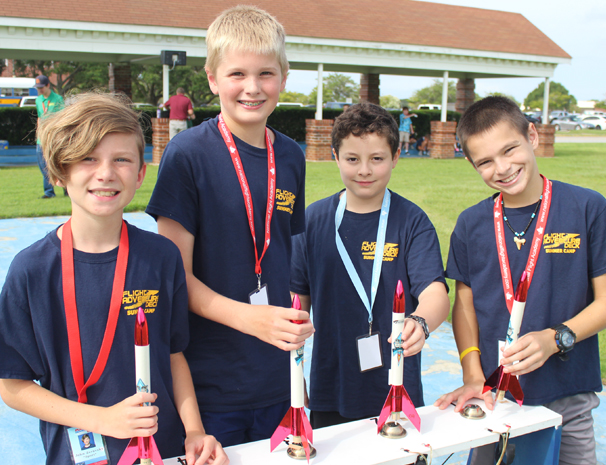
Programs
Featuring
— Women in all aspects of civilian and military aviation
— STEM Activities
— Simulators
— Special Women in Aviation Guest Speaker
— Free Swag
— Meet and Greet
— Complimentary screening of The Magic of Flight, featuring the Blue Angels and Patty Wagstaff
For more information, contact Dianna Hayden
dhayden@navalaviationmuseum.org
or Kathy McCartan
The Naval Aviation Museum Foundation offers Fly Girls, Girl Scout Day in the Spring of each year. The next Fly Girls event will occur in May 2023. Photos of Fly Girls 2022 can be found here [link]. If you have any questions about the Fly Girls Girl Scout event, please contact Dianna Hayden.
dhayden@navalaviationmuseum.org
Girl Scout fieldtrips/tours are available throughout the year. Please contact Dianna Hayden for more information.
Our new program, Homeschool Academy, will kick off in Winter, 2023. Please check back here for more information in December 2022.
Homeschool families, we need your input!
The Naval Aviation Museum Foundation offers two options for JROTC fieldtrips.
Option 1: STEM Station
— Features 2 or more STEM Station Stops where the students can learn about the science of flight.
— Is great for groups with limited time (less than 3 hours) for a fieldtrip.
— Allows for the most flexibility of the day.
— Centers around the four components of STEM.
Option 2: Profiles in Leadership and Courage
— Is great for groups with 4 or more hours in the museum.
— Follows a pre-approved itinerary.
— Includes a leadership talk and a specialized tour of the museum.
— Ends with a drill demonstration by the Cadets in the Blue Angels Atrium.
— Is available on Mondays and Tuesdays.
The Naval Aviation Museum Foundation currently offers two options for the mobile outreach program, Museum in Motion.
Option 1:
— Devotion
— Audience: Adults
— Length: 45 minutes
— Features content from the book, Devotion: An Epic Story of Heroism, Friendship, and Sacrifice by Adam Makos
— Venues: Libraries, Assisted Living and Retirement Facilities
Option 2:
— Astronauts, Aquanauts and Monkeynauts
— Audience: Children ages 4 – 9
— Venues: Libraries, Classrooms
— If you are interested in learning more about the Museum in Motion Outreach Program, please contact Dianna Hayden.
The Naval Aviation Museum Foundation (NAMF) is excited to announce its third annual Museum Masterpieces Art and Essay Contest. The theme for this year’s contest is To the Rescue. This theme commemorates the 80th anniversary of the first mercy mission conducted by Naval and Coast Guard aviation’s first helicopter, the HNS-1 Hoverfly in 1944.
Naval, Marine, and Coast Guard Aviators conduct many humanitarian operations including rescuing people at sea, delivering emergency aid, and providing disaster relief for hurricanes, tornadoes, and earthquakes. All entries should communicate the theme, “To the Rescue.”
The National Naval Aviation Museum offers Scout Saturday in Fall of each year. This event meets all requirements for the Aviation Merit Badge. Please check back for information about future Scout Saturday events. Photos of the 2022 Scout Saturday can be found here. If you have any questions about Scout Saturday, please contact Dianna Hayden.
dhayden@navalaviationmuseum.org
Scout fieldtrips/tours are available throughout the year. Please contact Dianna Hayden for more information.
Two virtual fieldtrips options are available for middle school students in grades 6 – 8. Each option is 30 to 45 minutes in length and restricted to 30 students (separate sign-ins) or one middle school class. These fieldtrips include live demonstrations with live question and answer sessions.
Option 1: The Four Forces of Flight
Option 2: Air Pressure
Teachers, if you are interested in scheduling a virtual fieldtrip with the National Naval Aviation Museum, please contact Dianna Hayden.
Scavenger Hunts
Mission: SEE & FREE
Level: Easy
This place is filled with animals: ducks, tigers, chickens, and even a SHARK! These animals are currently in hiding, but when you see them, you’ll set them free. Use the pictures to guide you and check the boxes when you see them!
Mission: DECODE
Level: Advanced
You have awakened to find yourself in an unknown place surrounded by airplanes. The year is 1935. You have a sense that there have been hard times in America, including a stock market collapse, a depression, a dust storm. But you also feel a sense of hope: A lady named Amelia has flown solo across the Pacific and the Hoover Dam has been completed. Still, you long toreturn to the days of Tik-Tok and cookie-dough ice cream. To do that, you must find keys to unlock the past and ESCAPE THE MUSEUM. You are now part of OPERATION DECODE. You will be unlocking the past from 1912 to 1935. When you think you’ve cracked the code, return here to try to break into the lock box. Inside will be your ticket OUT!
Mission: VICTORY
Level: Challenging
Oh no! You’re TRAPPED! You see the wood below your feet and a tall metal structure nearby. You are onboard THE USS CABOT, an AIRCRAFT CARRIER! The year is 1943 and you are in training to land planes on carriers. There was an attack at a place called Pearl Harbor over a year ago and you and the allies are in a battle. In order to help the allies win the war, you must find the keys to the past to ESCAPE THE MUSEUM.You are now part of MISSION VICTORY. You will be unlocking the past from 1938 to 1944. When you think you’ve cracked the code, return here to try to break into the lock box. Inside will be your ticket OUT!
Mission: HANGAR BREAK
Level: Top Secret
Field Trips
The mission of the Flight to Excellence (FTE) educational field trip program is to optimize the use of the National Naval Aviation Museum as an educational tool for teachers and visiting students in K-12th grade.The program achieves this by incorporating educational Giant Screen Digital Theater movies and accompanying Teachers’ Walking Tour Guides into a field trip. In addition to serving public, private and homeschooled students, we welcome Boy Scouts, Girls Scouts, church youth groups, YMCA, JROTC, Big Brothers/Big Sisters, etc. To make your reservation, please contact GloriaThompson at 850-308-8962 on weekdays between 7AM and 4 PM. You may also e-mail inquiries to gthompson@navalaviationmuseum.org. For every ten students, one chaperone is required and must always remain with their group. These chaperones will receive free admission to the attractions they are attending with their students. Any additional adults will pay the school rate for those attractions.
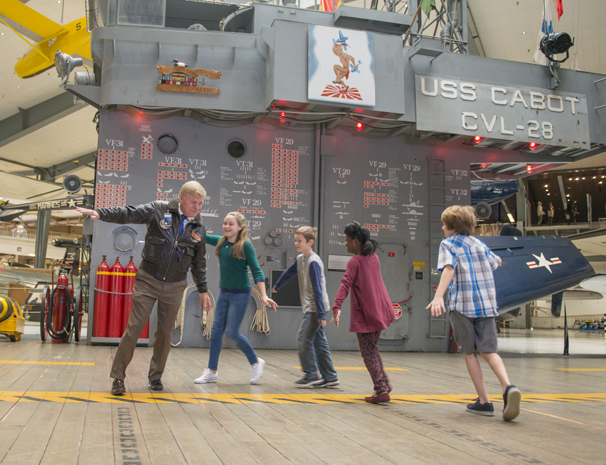
X-Stream Science
Further, the Naval Aviation Museum Foundation Education Department has partnered with the University of West Florida Public Media to create a series of STEM episodes, X-Stream Science. Each episode contains teacher/student support documents and an unique perspective of STEM learning.

Aircraft Preservation and Maintenance
As the Museum expanded its collection, it became active in the search for and recovery of naval aircraft wherever they could be found. Several rare warbirds emerged from the depths of Lake Michigan and the Pacific Ocean, including the only surviving Vought SB2U Vindicator; a rare SBD-2 Dauntless that participated in the Battle of Midway; an F4U-1 “Birdcage” Corsair; and a combat veteran F6F-3 Hellcat, among many others now fully restored and on display.
Over 40 rare warbirds were recovered through the efforts of the Museum and Foundation. Corroded, torn and deteriorated, these and other warbirds were brought to the volunteers and staff of the National Naval Aviation Museum and Naval Aviation Museum Foundation where thousands of man-hours were spent preparing them for their new mission.
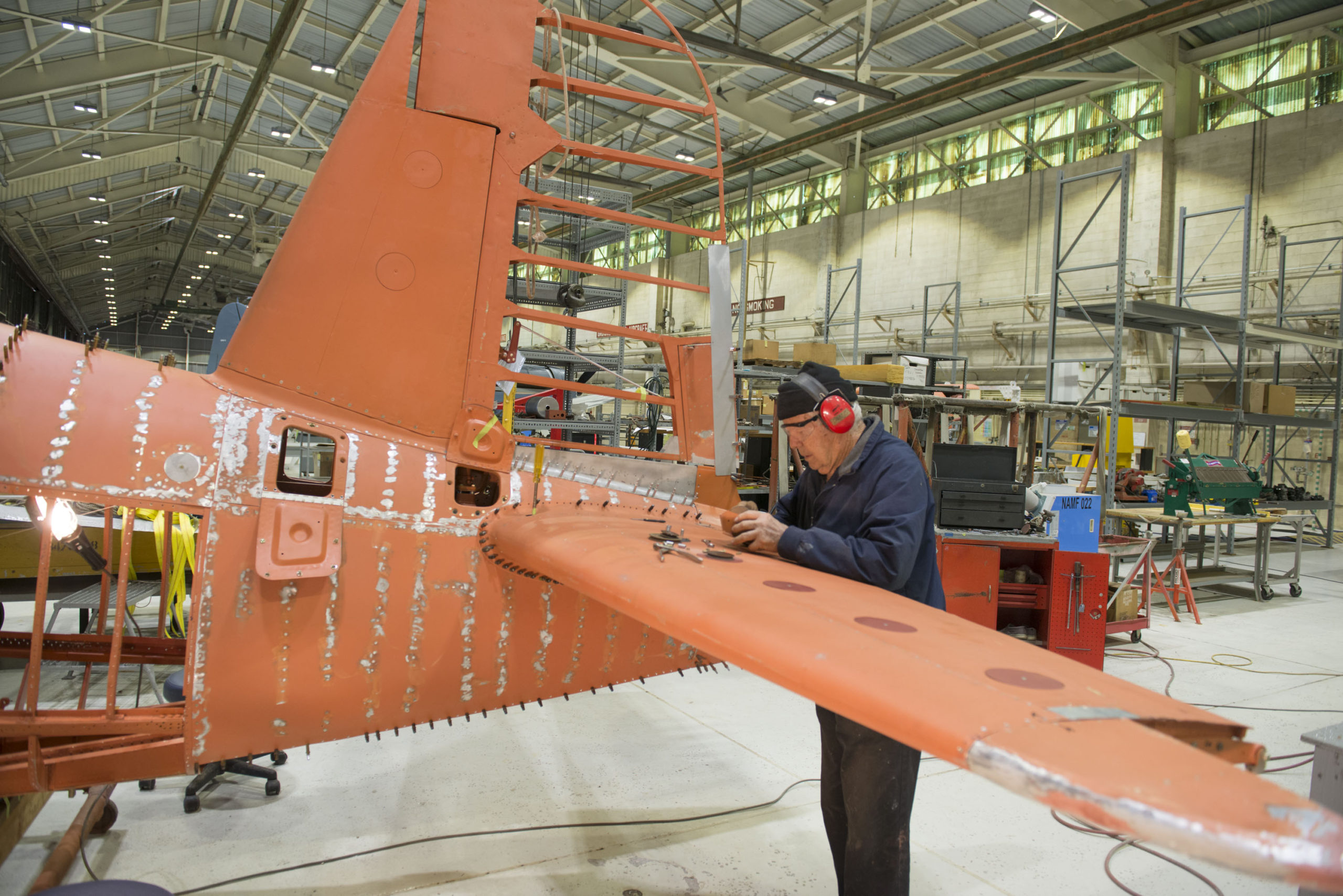
Exhibits and Collections
Though the aircraft are the largest of the Museum relics, they are just one dimension of the collection. More than 4,000 uniforms, flight gear, weaponry, medals and decorations add a personal touch to the story of Naval Aviation. Donations from organizations such as the Emil Buehler Trust have been key to providing the equipment and technology necessary for this preservation effort. The Emil Buehler Naval Aviation Library, which houses personal and official papers of prominent Naval Aviators, squadron records and a photograph collection numbering more 350,000 images, is a significant repository of naval history and draws researchers from around the world. Further, funds provided through the Foundation provide for the procurement and construction of new exhibitry, such as the Lunar Module replica in Hangar Bay One.
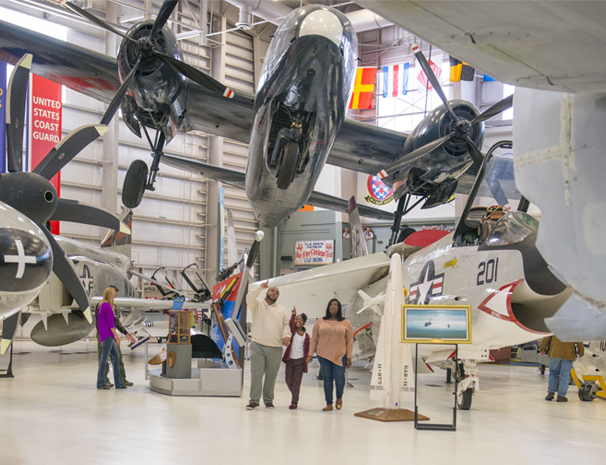
Special Events
The Foundation produces a number of special events each year as part of its efforts to increase public awareness of the role of Naval Aviation in America’s history. Since 1987, the Naval Aviation Museum Foundation has hosted a Naval Aviation Symposium in Pensacola. The nationally renowned two-day symposium averages 2,000 guests annually. Attendees include numerous active and retired flag and general officers, executives from the aerospace industry as well as young naval officers, sailors and Marines undergoing aviation training in Pensacola. The Foundation hosts additional family-friendly, community focused events throughout the year as well as the annual Glenn Miller Orchestra Concert and celebrations commemorating key moments in our history.
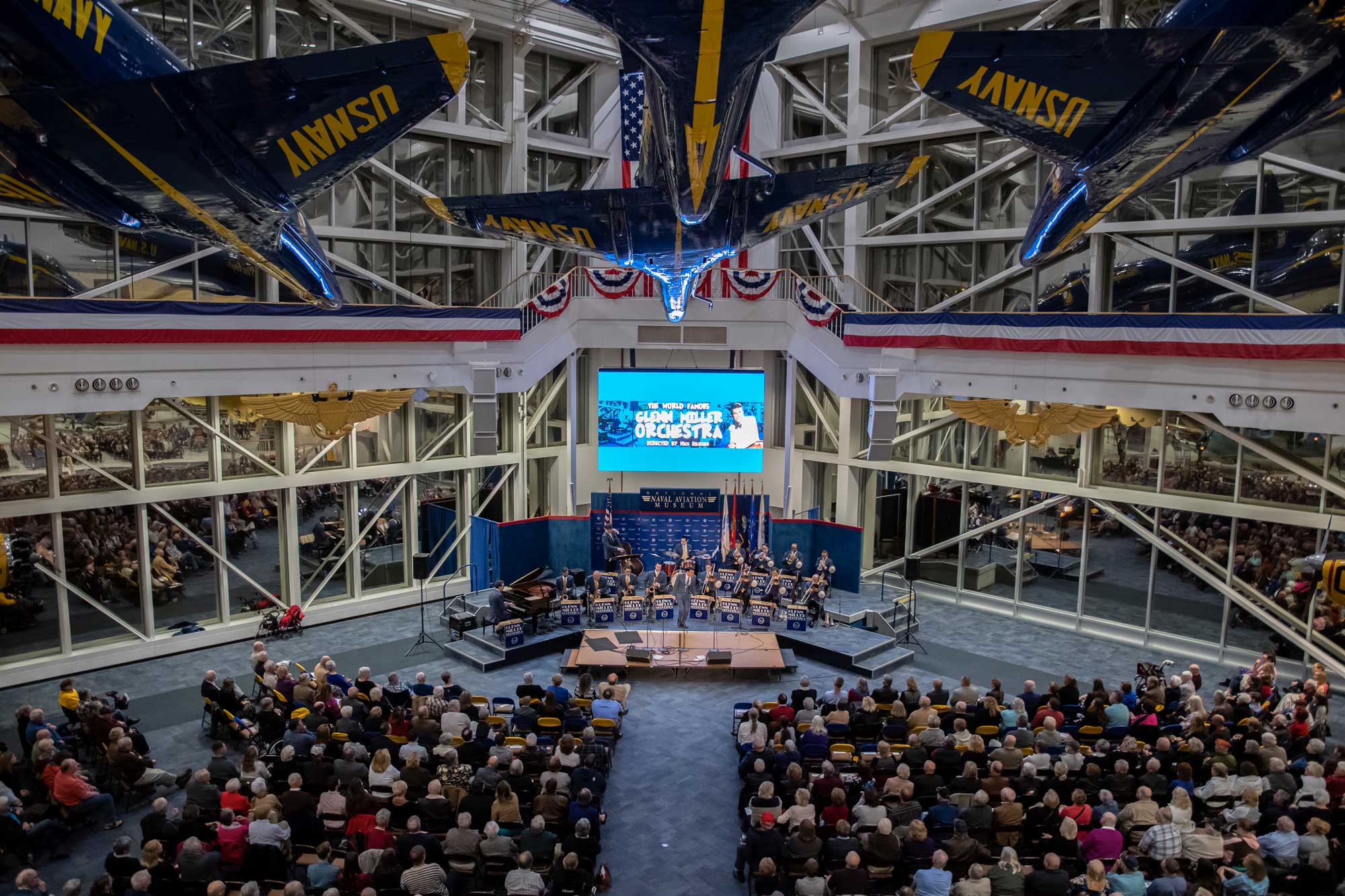
The World Famous Glenn Miller Orchestra
Join us on for an evening concert with the most popular and sought after big band in the world today. With its unique jazz sound, the Glenn Miller Orchestra is considered to be one of the greatest bands of all time.
Hear all the timeless classics like In the Mood, Moonlight Serenade, Chattanooga Choo Choo, Pennsylvania 6-5000, String of Pearls and Tuxedo Junction at the National Naval Aviation Museum. Perfect for all ages! You won’t want to miss it.
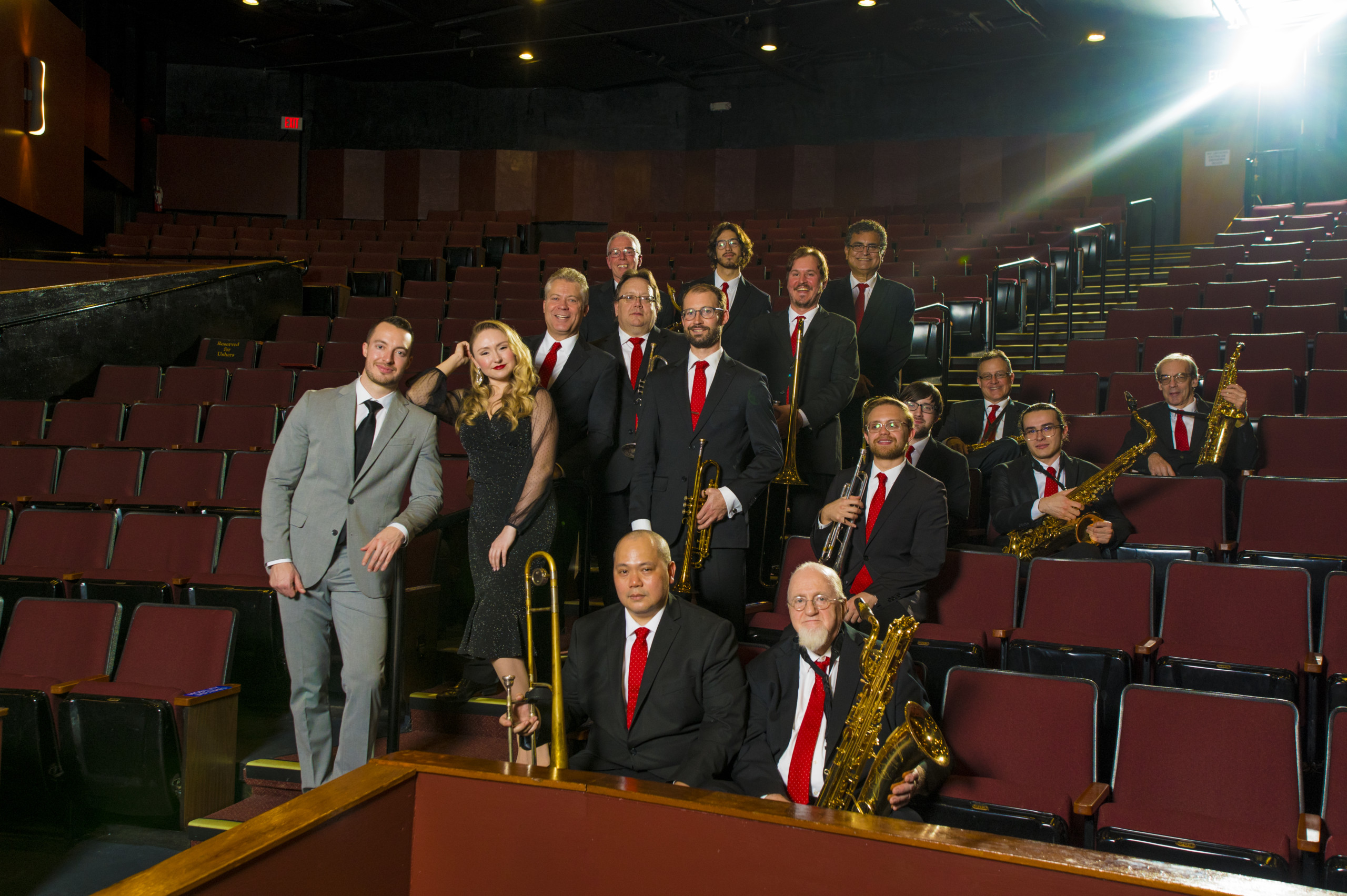
Symposium
Since 1987, the Naval Aviation Museum Foundation has hosted a Naval Aviation Symposium in Pensacola. The nationally renowned two-day symposium averages 2,000 guests annually. Attendees include numerous active and retired flag and general officers, executives from the aerospace industry as well as young naval officers, sailors and Marines undergoing aviation training in Pensacola.
Attractions and Operations Support
The Foundation further supports the National Naval Aviation Museum by providing services necessary for its day to day operation. These include all marketing activities, development and maintenance of the Museum’s website and social media and custodial services which keep the Museum one of the most pristine facilities in the world. The Foundation also operates a number of attractions within the Museum, such as our Naval Aviation Memorial Giant Screen Theater, Apollo 11 Virtual Reality Experience, MaxFlight and Motion Based Simulators, the Blue Angels 4D Experience and the Flight Deck gift shop. Proceeds from these attractions go towards Foundation overhead and the remainder is gifted to the Museum.
